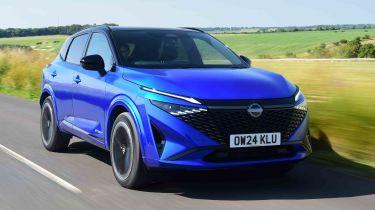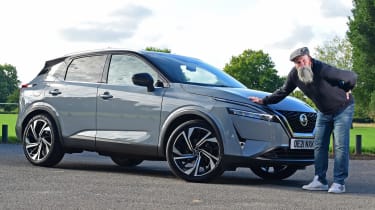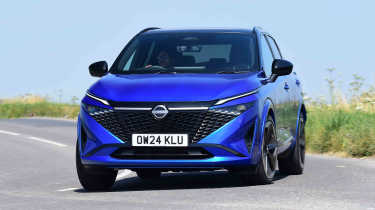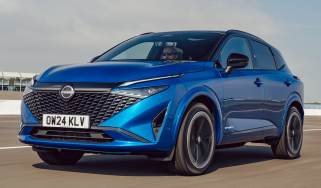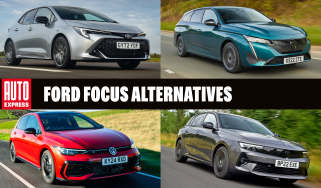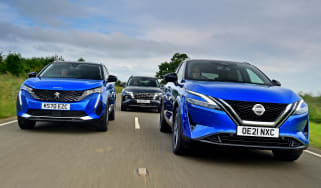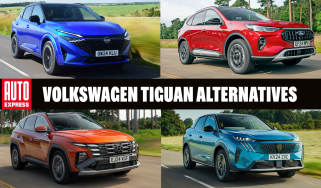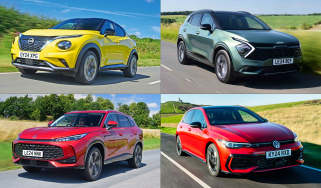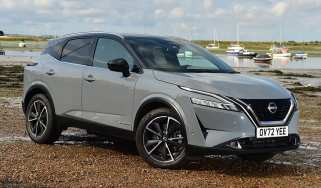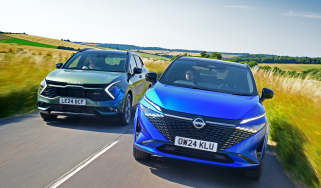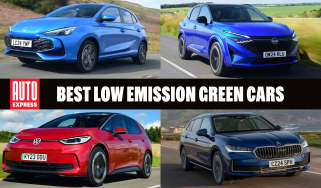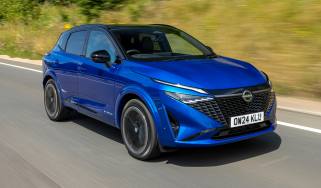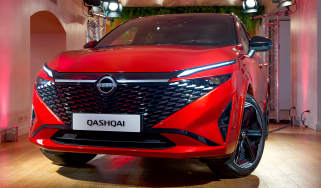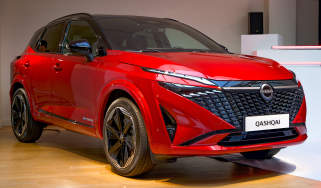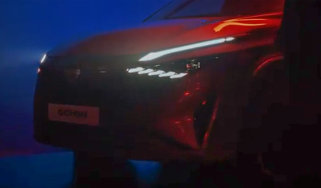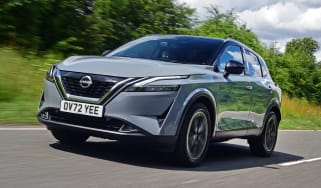Nissan Qashqai review
The Nissan Qashqai moves forward in a few key areas, but ultimately can’t compete with the best in its class

Our opinion on the Nissan Qashqai
The sales charts don’t lie. UK buyers love a Nissan Qashqai and there’s no doubt that this mid-size SUV, built in the north east, is a more inviting proposition following its mid-life facelift. Qashqai has sharper looks, better tech and a higher quality feel in the cabin following the most recent changes, and there wasn’t a whole lot wrong with the rest of the package anyway.
Few sectors of the car market are more competitive than the one where the Qashqai plies its trade, but Nissan’s effort (the UK’s second best-selling car in 2023) stands out by offering consistency across the board rather than excelling in any one area. Good to drive, efficient, practical, well-equipped, and tightly priced, despite not being a class leader, the lack of weaknesses gives it an edge.
| Key specs | |
| Fuel type | Petrol, hybrid |
| Body style | Mid-size SUV |
| Powertrain | 1.3-litre, 4cyl, turbocharged, mild-hybrid petrol, front-wheel drive 1.3-litre, 4cyl, turbocharged, mild-hybrid petrol, four-wheel drive 1.5-litre, 3cyl, petrol plus 1x e-motor, front-wheel drive |
| Safety | 5-stars (Euro NCAP, 2021) |
| Warranty | 3-year/60,000-mile |
About the Nissan Qashqai
The Nissan Qashqai is probably what you’d see in the encyclopedia today if you turned to the “car” page. It’s one of the best-sellers in an enormously popular segment (mid-size SUVs like this don’t just sell well in the UK or Europe, but globally too), offers five doors, five seats and a decent-sized boot, a range of in-vogue mild hybrid and hybrid powertrains, and while it’s not cheap, it’s also not priced like a premium vehicle, putting it within the reach of plenty of customers.
Used - available now

2018 Nissan
Qashqai
42,980 milesAutomaticPetrol1.3L
Cash £13,600
2022 Nissan
Qashqai
20,973 milesManualPetrol1.3L
Cash £15,700
2018 Nissan
Qashqai
25,807 milesAutomaticDiesel1.5L
Cash £14,400
2017 Nissan
Qashqai
66,219 milesManualPetrol1.2L
Cash £8,787That pricing spans from just over £30,000 for a mild-hybrid Acenta Premium model, to a little under £43,000 for a top-spec Tekna+ with the full hybrid system, or the 154bhp mild hybrid with four-wheel drive and an automatic gearbox. Because pricing of the top models trips past the £40,000 mark, these versions can be expensive to tax, but otherwise the Qashqai is in the same ballpark as its rivals in essential metrics like price, fuel efficiency, tax, and performance.
It isn’t the largest mid-size SUVs around, which puts a bit of a squeeze on passenger space. However, the latest models have a quality interior that doesn’t put too much emphasis on distracting touchscreens – you do get an infotainment system, but most of the major controls are still operated outside of it via easy to operate buttons and dials.
Economy starts at around 44mpg from the front-wheel drive mild hybrids, to mid-50s for the e-Power full hybrid – which is one of an increasing number of hybrids where the combustion engine is used as a generator of electricity to supply power to the electric motor that drives the wheels. Driving this model is a little like driving an electric car in terms of smoothness, although it can’t go too far on electric power alone before the engine needs to switch on. If you want a true electric car driving experience, you’ll need to look towards the Nissan Ariya.
Performance & driving experience
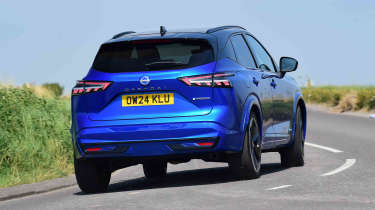
| Pros | Cons |
|
|
On its launch in 2021, the third-generation Nissan Qashqai was an impressive 60kg lighter than its predecessor, despite being stiffer and safer. While it’s a little more dynamic than its predecessor, it’s not one of the more entertaining or involving SUVs in this class to drive – but for most customers, the Qashqai’s comfort and refinement will be of greater importance.
Most cars in the Qashqai lineup use a torsion-beam rear suspension layout, although a more sophisticated multi-link set-up is fitted to top-spec models equipped with 20-inch alloy wheels. The standard set-up we’ve tried fidgets a little over smaller bumps, but generally, the Qashqai rides very well, and the more sophisticated suspension on top-spec cars offsets the potential downsides of the larger wheels. It’s better at dealing with bumps and potholes than many rivals, and feels more responsive than a Skoda Karoq.
Push on a bit, and there’s body roll, but it's quite gradual and controlled. The steering is light (unless you select sport mode, which adds some extra heft) and devoid of feel, but it's direct enough and makes the car feel nimble enough through quick direction changes.
Performance, 0-60mph acceleration and top speed
The Nissan Qashqai’s mild hybrid-assisted 1.3-litre engine is refined and only becomes noticeable under hard acceleration when the noise is far from intrusive. The 138bhp version offers passable performance, with 0-62mph taking 10.2 seconds and a 122mph top speed.
Moving up to the 154bhp car improves things a little, with the quickest version being the front-wheel drive auto, which takes 9.2 seconds to reach 62mph from a standstill. The six-speed manual variant is a touch slower than the optional Xtronic CVT, needing 9.5 seconds to get to 62mph. Neither of these engines makes the Qashqai feel particularly fast, but they deliver good refinement and don’t sound bad when revved harder.
The 1.5-litre, three-cylinder e-Power model has a much healthier 187bhp and cuts the 0-62mph time to 7.9 seconds. Power builds smoothly, thanks to the e-Power always driving on its electric motor, even when the engine is running; the engine essentially serves as a generator. There’s a slight pause when you ask for maximum performance when overtaking, but it quickly perks up and delivers everything it’s got once the engine revs have picked up.
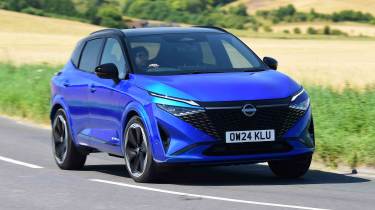
Town driving, visibility and parking
The manual version is easy enough to drive in town, and is preferable over the regular 1.3-litre petrol engine when equipped with an Xtronic CVT automatic transmission, which can dither when moving away from a stop – not ideal for entering a busy roundabout.
Even better is the e-Power hybrid. Due to the drive for the wheels coming from an electric motor, it feels more like an EV with a smooth and near instantaneous accelerator response.
B-road driving and handling
When it comes to SUVs that have been designed more to ease the burden of family life, fun isn’t really a top priority. The same is true for the Qashqai, which can’t match the sharper Ford Kuga for handling prowess, but it’s agile enough for most buyers and feels stable and secure at higher speeds. The steering provides the sort of precision expected of a road-biased SUV, although it isn’t brimming with feedback.
The suspension competently deals with the worst road surfaces, but we’d like it if the springs and dampers could provide a little more give. We’d advise you to stick with the smaller 17 or 18-inch wheels fitted to Acenta Premium and N-Connecta in order to get a more comfortable ride.
Motorway driving and long-distance comfort
We haven’t yet been able to try the updated Qashqai side by side with its predecessor to determine whether the additional sound deadening has made a difference, but we can say that the latest Qashqai remains a quiet car at speed.
There’s some engine noise to be heard when accelerating hard in all versions, but it isn’t intrusive and settles into the background once you’re up to cruising speed. Road noise is contained well, and while wind noise picks up at speed, the Qashqai cabin is generally a quiet place to be on the move. Comfort and stability at high speed are great too.
| Model | Power | 0-62mph | Top speed |
| Qashqai 1.3-litre DiG-T mild-hybrid petrol 2WD | 138bhp | 10.2 seconds | 122mph |
| Qashqai 1.3-litre DiG-T mild-hybrid petrol 4WD | 154bhp | 9.9 seconds | 123mph |
| Qashqai 1.5-litre hybrid e-Power 2WD | 187bhp | 7.9 seconds | 105mph |
MPG & running costs
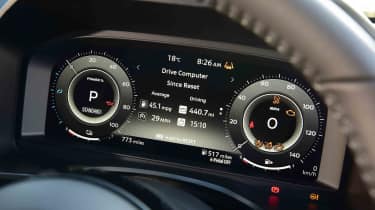
| Pros | Cons |
|
|
The Nissan Qashqai 1.3-litre mild-hybrid petrol engine provides either 138bhp or 156bhp. The lower-powered unit returns up to 44.8mpg on the WLTP combined cycle, with CO2 emissions of 142g/km. Opting for the 156bhp version doesn’t significantly reduce fuel economy, but adding four-wheel-drive sees a fall to 40mpg and a CO2 figure of 157g/km. All models come with stop/start tech, along with an Eco drive mode to help eke out extra miles from a tank of fuel.
The Qashqai isn't offered with plug-in hybrid power like rivals such as the Hyundai Tucson and Kia Sportage. Instead, the brand sees e-Power as the stepping stone from mild-hybrid to a full EV. The Qashqai e-Power is technically a range-extending hybrid, as the petrol engine's sole purpose is to charge a 2.1kWh battery that feeds the electric motor that drives the front wheels. The result is up to 53.3mpg on the WLTP cycle, plus CO2 emissions of 119g/km.
Curiously, when we first drove the e-Power model, the best we could manage in a heavily congested urban environment – where the more electrified powertrain should have shone – was 44mpg, and it wasn’t until we escaped the city that the figure climbed to around 47mpg. On a more recent drive in Portugal on a hilly route mainly comprising twisty B-roads, an e-Power car on 20-inch wheels was averaging around 39mpg, which was a disappointing result given we were able to get 37mpg from the 156bhp mild hybrid with a manual gearbox.
| Model | MPG | CO2 | Insurance group |
| Qashqai 1.3-litre DiG-T mild-hybrid petrol 2WD | 44.8mpg | 142g/km | 12 |
| Qashqai 1.3-litre DiG-T mild-hybrid petrol 4WD | 40.4mpg | 157g/km | 21-22 |
| Qashqai 1.5-litre hybrid e-Power 2WD | 53.3mpg | 119g/km | 24-30 |
Insurance groups
Buying an entry-level Qashqai Acenta Premium means that you won’t be forking out too much cash to insure your new family wheels, but prices rise as you climb the range. The cheapest 138bhp version sits in group 12, and the extra power of the 156bhp Acenta Premium Xtronic CVT car puts it in group 22, with top-spec Tekna+ versions in group 23. In comparison, the Hyundai Tucson range starts from group 18 and climbs to group 24 for the plug-in hybrid in the posh Ultimate specification.
The Qashqai e-Power hybrid models will be more expensive to insure, starting in group 24 and rising to group 32 for a top-spec Tekna+ model.
Tax
Business users won’t be hugely motivated by the Qashqai’s numbers as with the basic Acenta Premium car, they’ll be paying a 34 per cent Benefit-in-Kind rate, while a top-spec mild-hybrid model is in the 37 per cent bracket. The e-Power’s improved economy cuts the BIK rate down to 29 per cent, but it can’t match a plug-in hybrid or electric car for company car tax efficiency. Higher trim versions of Qashqai can go over the £40,000 barrier with a few choice options, and then the car will incur the luxury car tax supplement, which applies in years two to six of registration.
Depreciation
Our data suggests the latest facelifted Nissan Qashqai will hold onto between 46 to 50 per cent of its value after a three-year/36,000-mile ownership period, with the 1.3 MHEV 158 N-Connecta Xtronic 4WD predicted to lose the most, and the 1.3 MHEV 158 N-Design 2WD manual expected to maintain the most value.
For comparison purposes, the Ford Kuga is expected to hold onto 53 per cent of its value over the same period, while the Hyundai Tucson range is between 53 and 56 per cent. However, the Kia Sportage is predicted to maintain more of its value than any of the cars mentioned here, hanging on to between 51 and 58 per cent of its value over the same period.
To get an accurate valuation for a specific model, check out our valuation tool...
Interior, design & technology
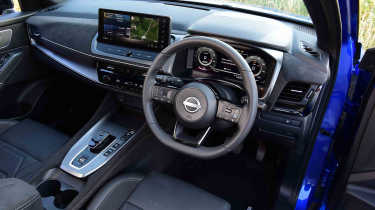
| Pros | Cons |
|
|
When the Mk3 Nissan Qashqai launched, its exterior design wasn’t that far removed from the previous model. The 2024 facelift added a more distinctive front end, similar to the Ariya electric car, that helps Nissan’s offering stand out next to more adventurously styled rivals like the Peugeot 3008 and the Toyota C-HR.
The technology highlight is probably Nissan’s Around View Monitor system, which generates an all-around view of the car when manoeuvring to help avoid shunts. There’s now a 3D function that renders an external image of the car and its surroundings from eight different angles, and an ‘invisible hood view’ – as seen on Land Rover models – which generates an on-screen image of what the wheels are doing beneath the bonnet. Nissan says it’s good for avoiding kerbs and positioning the car in car washes, which seems like a more likely use case than hardcore off-roading. Also potentially useful is a T-junction view, which uses a camera on the Qashqai’s nose to help you check for coming traffic when pulling out of blind junctions.
Nissan Qashqai prices now open at just over £30,000, and all cars get the impressive 12.3” touchscreen. Base Acenta Premium models don’t have the Google-powered infotainment features, and make do with wired Apple CarPlay and Android Auto, while higher spec models offer wireless connections. They also miss out on all the body-coloured exterior trim, which spoils the look of the Qashqai to an extent.
With this in mind, the £2,000 premium for an upgrade to N-Connecta trim feels worthwhile. You get the improved Around View Monitor system, ambient lighting and a wireless charging pad, among other things, but the exterior trim is only partially body-coloured. You’ll have to find another £2,500 for an N-Design if you want full body-colouring on the lower bumpers, and this also adds LED lights with 20-inch wheels. For the same price as the N-Design, Tekna models forgo some of the styling add-ons but get the full suite of ProPilot driver assistance tech, a head-up display, and a lot more besides.
Tekna+ is the height of mid-size SUV luxury with quilted, massaging leather seats and a Bose stereo. Unfortunately, it’s £4k more than a Tekna, which feels a bit rich, in our opinion. N-Connecta is a good value, unless you really want to make a statement with the sharpened looks of the N-Design.
Interior and dashboard design
The Qashqai’s dashboard layout is logical, and we approve that all the easy-to-use physical buttons and dials remain, including the ones for the air-conditioning, which is a big plus point in our book over rivals like the Ford Kuga, which has gone all in on touchscreens.
Opting for the N-Design trim gets you a large panoramic glass sunroof, letting in a huge amount of light into the interior to help brighten things up, which might be useful if you plan on tackling a number of long trips in your Qashqai.
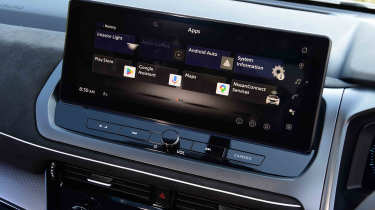
Materials and build quality
The changes inside the Qashqai included some nicer materials on higher spec cars and many new or enhanced tech features. The posher models get a very large helping of Alcantara fabric (on N-Design cars) or soft leather (on Tekna models). These upmarket materials coat the dash, door inserts, and armrests, and it really adds an air of quality – we’re just unsure how well the Alcantara will stand up to regular encounters with sticky-fingered kids. There’s also some very fetching metallic-effect plastic trim around the gear selector.
Infotainment, sat-nav and stereo
In the technology department, the big change is the addition of Google’s in-house infotainment technology. The Google Maps navigation functionality from N-Connecta and above is first class (especially if you’re an Android user familiar with the interface), and all bar the base models get it along with the ability to sign-in to your car with your Google account – transferring favourite locations and other information in the process. There’s ‘hey Google’ voice assistant control, too, significantly reducing the need to connect your phone to the car. Unless, that is, you plump for the entry-level Acenta Premium, which misses out on built-in Google software, and you’ll need to use a navigation app from your smartphone instead.
Boot space & practicality
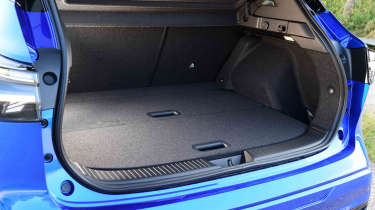
| Pros | Cons |
|
|
Family buyers will be impressed by the practical touches of the Nissan Qashqai. The rear doors open to 85 degrees, which means – provided there isn’t a car parked close next to you – that fitting a child seat (and even putting a child into their child seat) is a lot easier. A reversible boot floor with a wipe-clean surface is another thoughtful addition.
The front seats are comfortable and supportive, with all Qashqai models featuring a steering wheel with reach and rake adjustment. Storage in the cabin is quite limited, with the main options being the small glovebox, slim door pockets, a deep cubby under the armrest, and a pair of cup holders in the centre console. There’s also a shelf for your phone that becomes a wireless charging pad in higher spec models.
| Dimensions | |
| Length | 4,425mm |
| Width | 1,835mm (2,084mm with mirrors) |
| Height | 1,575mm |
| Number of seats | 5 |
| Boot space | 400-504/1,447 litres |
Dimensions and size
The latest Qashqai is a bigger car than the second-generation model it replaces, at 4,425mm in length, 1,625mm in height, and 1,835mm (2,084mm including mirrors) in width. A 35mm increase in length, and 32mm of extra width mean it’s still a little smaller than a Ford Kuga, but pretty much the same size as a Peugeot 3008.
Driving position, seats & space in the front
The front seats are comfortable, offering good support, but there’s no question that its rivals are a bit bigger inside. Buyers considering the panoramic sunroof option (standard on Tekna and above) should be aware that this eats into the available headroom.
Seats & space in the back
In the rear, a six-foot tall passenger can sit behind a driver of similar dimensions if they don’t mind pushing their knees into the padded seat back a little. Headroom is also manageable, but the middle berth in the back will be a squeeze thanks to the raised seat base cushion and the hump in the floor where your feet need to go.
During our own tests, we found the Qashqai to have less headroom when compared with the Peugeot 3008 and Hyundai Tucson, nor is it as roomy inside as a Vauxhall Grandland or Skoda Karoq. There's still plenty of space for passengers under six feet, and overall, it’s roomy enough for daily use. As with most mid-size SUVs, two ISOFIX child seat mounting points are provided on the rear seats' outer positions.
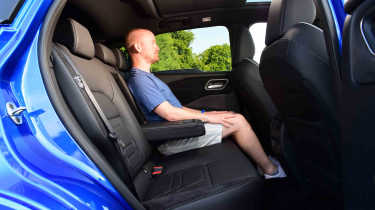
Boot space
The Nissan Qashqai’s boot provides a 504-litre maximum capacity that’s still down on the Peugeot 3008, Hyundai Tucson and Kia Sportage. In fact, the N-Connecta, Tekna and Premiere Edition versions have a reduced 479-litre boot capacity due to standard-fit luggage boards, which separate the boot into individual sections. Still, there's no loss in luggage capacity with the hybrid Qashqai e-Power.
The Qashqai has a high boot lip, so buyers will find loading awkward items more of a pain than it should be, while Nissan has missed a trick by not fitting levers in the boot that enable you to fold the rear seats quickly. The Nissan trails its rivals with its rear seats down too, with just 1,447 litres available compared to the roughly 1,800 litres you get in a Kia Sportage, Tucson or Karoq.
Towing
The towing capacity of the Nissan Qashqai depends on which engine you choose, but all petrol versions should provide enough capability for most buyers’ needs. The maximum braked trailer towing capacity ranges from 1,400kg for the front-wheel-drive 138bhp model, to 1,800kg for the more powerful 156bhp version. Don’t pick the e-Power model if you plan to pull a caravan, because it only has 750kg of towing capacity.
Reliability & safety
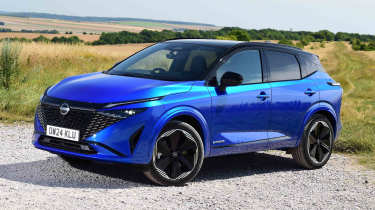
| Pros | Cons |
|
|
The Nissan Qashqai finished in a rather disappointing 42nd place out of 50 cars in the 2024 Driver Power customer satisfaction survey. While that is ahead of the Volkswagen Tiguan (45th), it is behind the Ford Kuga (37th), Skoda Karoq (19th), and Kia Sportage (11th).
There’s more positive news for the Nissan brand, which moved up the rankings from 19th position (out of 32 car brands) in our 2023 Driver Power manufacturer ratings, to 15th place out of 32 manufacturers in the 2024 survey. The brand did well for child-friendly features, but was criticised for overall quality and road handling.
Family buyers, in particular, will be impressed by the Qashqai's five-star safety rating from industry body Euro NCAP in 2021. Both adult and child occupant safety are rated at 91 per cent, with Safety Assist systems scoring an outstanding 95 per cent.
The standard kit is comprehensive, with Nissan’s Intelligent Mobility tech including a blind spot warning to alert you to cars approaching beside you on the motorway, a rear cross traffic system to alert to cars crossing from behind when reversing, traffic sign recognition to let you know of the speed limit, an automatic emergency braking system with pedestrian and cyclist recognition to prevent collisions with vulnerable road users, a forward collision warning to alert you if it thinks you’re about to collide with something, Intelligent cruise control to keep you a safe distance from the car in front, and a high beam assist function to automatically put the main beam on when there’s no oncoming traffic to dazzle.
Many drivers will be disappointed to learn that, to meet EU rules and appease the Euro NCAP crash testing body, safety assist features like the speed limit and lane departure warning systems now reactivate every time you start the Qashqai. Nissan has addressed this by adding a new Driver Assist Custom Mode that lets you choose your preferred settings for these aids and activate them at the touch of one button on the steering wheel.
Nissan offers a standard three-year/60,000-mile warranty for the Qashqai, although if you pay an extra £340 you can extend your Qashqai's warranty for an additional 12 months, but the 60,000-mile limit still applies. You also get three years of free roadside assistance with the Qashqai.
Service intervals for petrol versions of the Qashqai are annually or every 18,000 miles, whichever comes first, while fixed-price service plans are available from your local Nissan dealer.
The hybrid e-Power requires more regular maintenance, needing a service every 9,000 miles or annually, whichever comes first.
| Key standard safety features | Euro NCAP safety ratings |
|
|
Buying and owning
- Best buy: Nissan Qashqai 1.3 Mild Hybrid (MHEV) 158PS N-Connecta
Our pick of the Qashqai range is the more powerful version of the two mild hybrid models, ideally in slick-shifting manual form, front-wheel drive, and in upscale Tekna trim.
While not as economical as the e-Power model, the 158bhp 1.3 MHEV is not as expensive to buy up front and avoids creeping over the £40,000 mark at which your VED tax burden is a lot higher. The more powerful of the two mild hybrid engines should be a little more adept at hauling a car full of people and luggage, while the manual gearbox is easy enough to use and feels a little more responsive in town driving than the sometimes slovenly Xtronic CVT. There’s no economy penalty between the 138bhp and 154bhp models either, because both get the same 44.1mpg combined rating. Since opting for all-wheel drive harms economy, and we doubt most buyers are likely to need it, you can safely leave it off the options list.
The mid-range N-Connecta trim will provide you with all the equipment you'd need without pushing the price up to where it clashes with our favourite mid-size SUV, the Hyundai Tucson.
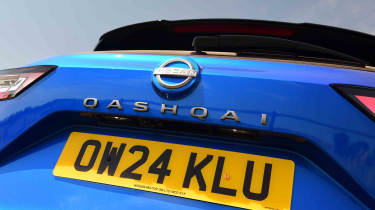
Alternatives
If you’re in the market for a mid-size SUV, there’s no shortage of options to choose from. Some of our current favourites include the impressive Hyundai Tucson, its Kia Sportage sister car, the revitalised Ford Kuga and the stylish Peugeot 3008, although the VW Group offers a capable trio in the shape of the SEAT Ateca, Skoda Karoq, and Volkswagen Tiguan.
If you’re sold on the Qashqai, you certainly won’t be alone. Hundreds of thousands of UK buyers have seen it as a good idea since 2007. The appeal of the current car revolves around its comfort, quality and impressive Google-based infotainment tech. Keen drivers may want to look elsewhere because neither the driving experience nor the level of performance from the engines does much to excite.
Nissan has tailored its mid-size SUV to deliver the goods for family buyers in this competitive market and succeeded in ticking most of the boxes that matter. The most recent changes give it a more distinctive appearance to help it stand out in a crowded marketplace, but it is still the Qashqai’s more prosaic qualities that give it an edge.
Nissan Qashqai Tekna+: long-term test
In 2022, our Web producer, Pete Baiden, spent nearly a year behind the wheel of a top-of-the-range pre-facelift Nissan Qashqai Tekna+ and was left with mixed feelings about it. On the one hand, it was a very practical car, with thoughtful touches such as the rear doors that opened to nearly 90-degrees, which made putting children into car seats easy, and a split-height boot with no loading lip that helped when transporting a buggy.
However, the driver’s seat left him with backache after every long trip he took in it, whereas previous long term test cars such as the SsangYong Korando and SEAT Tarraco had not. Even the massage function on his high-spec Qashqai didn’t help, with Pete likening the sensation to being kicked in the back by one of his children. You can read the full long term test here...
Used and nearly new
You won't find the popular Nissan Qashqai in short supply on the used market. Since it first arrived in the UK in 2007, the Japanese mid-size SUV has positioned itself as the 'go-to' option for families needing a practical car that's good to drive. The Qashqai may have developed a somewhat anonymous image over time, but it was quite revolutionary when launched – offering buyers a funky new crossover style.
Nissan Qashqai history
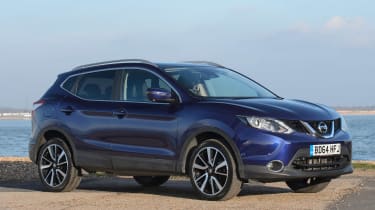
Nissan Qashqai Mk2: 2014-2020
The Mk2 Nissan Qashqai range offers reasonably efficient engines and decent levels of kit, although the base cars can are sparse. There has been mixed feedback regarding the Qashqai's overall reliability, so check over the car's history and ensure any recall notices have been attended to. Both front- and four-wheel-drive models are available, along with manual and CVT auto versions, so buyers should be well catered for. Read our full Mk2 Nissan Qashqai buyer’s guide here…
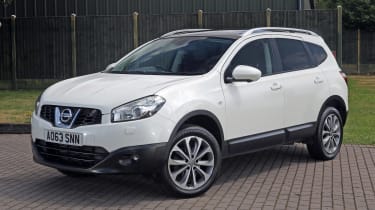
Nissan Qashqai Mk1: 2007-2013
The Mk1 Nissan Qashqai still provides great family transport. Its crossover-style good looks and useful practicality mean it will still appeal to buyers seeking a capable SUV. Of course, time has marched on, but the first-generation Qashqai is becoming more affordable, and its low running costs will suit those on a budget. Look out for the reasonable mid-spec Acenta models, which include parking sensors and climate control, while if you're after a little more luxury, then the top-spec Tekna versions, boasting leather upholstery heated seats and a panoramic glass roof, could hit the spot. Read our full Mk1 Nissan Qashqai buyer’s guide here…
Nissan Qashqai pictures
Frequently Asked Questions
Nissan offers a bog-standard three-year or 60,000-mile warranty with the Qashqai but you can extend it for a fee
